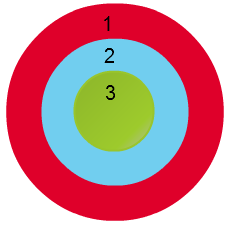
What separates fitness professionals from one another, and makes some individuals more competent and qualified is how often they’re investing in and pursuing their continuing education. The Four Concentric Circles of Personal Trainer’s Continuing Education described in this article illustrates how fitness professionals generally fall into four categories (i.e., circles) based on their interest and efforts in pursuing their continued education.
Each circle is smaller than the one preceding to represent the fact there is a much smaller population of fitness professionals who fit the corresponding criteria. This is important because it helps us to see if our actions as fitness professionals, from a continuing education perspective, match our professional goals. As you go through the quick and generalized overview of each circle below, it’s important to ask yourself questions including:
• What circle am I in based on how much time and resources I invest in improving my knowledge and skillset?
• What circle should I be in if I’m trying to deliver the best training services to my clients?
• What circle do I need to be in if I’m trying to be the best trainer in my area?
• What circle do I need to be in if I have the goal of becoming a top leader/education provider in this field?
Circle #1
The first circle, which includes the largest population of trainers, describes those who get much of their information from predominantly mainstream, commercialized names (e.g., pro athletes, fitness celebrities, etc.) that are notoriously unreliable sources who promote pseudoscience, while remaining uninformed of the more reliable sources are of scientifically-founded information within their field.
Trainers in this circle often find the quickest and easiest method of acquiring CECs/CEUs to keep their certification current. They are also the ones whose primary method and view of getting their continued education is using mainstream media simply to find new, trending exercises and workout ideas they can use to “push” their clients.
Circle #2
Trainers in this circle, although they’re more serious and spend more time on their continued education than those in the previous category, tend to spend most of their educational time and money learning about the training concepts and techniques that they themselves think are aligned with their own training goals instead of learning better and more effective ways to help clients achieve their goals. Their continued education is still somewhat narrow and therefore limited relative to the trainers in the following categories.
Put simply, there are trainers who act as fitness professionals and others who act as fitness hobbyists. Fitness hobbyists try to get other people excited about their hobby, regardless of their individual goals, while the fitness professional fits the workout program to the client’s goal, not based on their bias.
Individuals in this category tend to be fitness hobbyists. Because they tend to pursue the educational ventures in which they’re personally interested in, they usually do something to the client instead of doing something for the client by providing a training direction based mostly on their own chosen training philosophy (i.e. bias) rather than delivering a true “personalized” workout program. In other words, these trainers often end up giving their clients private lessons on what they like to do instead of using the best modalities for the client to achieve their goals.
Circle #3
Trainers in this category not only spend more time, energy and resources on their continuing education than those in the previous categories, they’re also focused on pursuing education ventures that will benefit their clients to achieve their goals in the safest manner possible. Because of this, these individuals tend to have a much better idea of what is relevant in their field and know the reliable sources of scientifically-founded training information.
It is these individuals who are often attending live events and purchase informational products – whenever they can afford them – purely for the education provided, not simply for the CECs. They are often reading a wide variety of training-related books, articles, blogs and research studies.
This category consists of a much smaller portion of the trainer population than those in the previous categories. This explains why many gyms with a staff of 20 or more trainers don’t have a single trainer in this category. If they do, it’s usually just one trainer, maybe two. On the other hand, there are many smaller, more private training facilities whose entire staff of trainers fall in this category. Those places are special!
Circle #4
These are the rare trainers who aren’t just passionate and dedicated to regularly pursing their continued education; they’re obsessed with it. They are the ones who spend all of their free time and most, if not all, of their expendable income (i.e., “fun money”) on their continuing education; constantly reading articles and research, buying books and video courses/products and attending as many live events as they can afford. Although these are work-related, to the trainers in this circle, engaging in their continuing education is enjoyable and exciting to them.
In other words, these are the trainers who can't stop thinking about training; are constantly questioning themselves and evaluating their practices; are always looking to talk shop and can’t help but get excited when they’re discussing their career. It’s because of this, trainers in this category often have a difficult time relating to trainers in the first and second circles, and can sometimes get upset when other trainers don’t hold themselves to the same standards of practice.
Trainers in this category are often happier engaging in continuing education ventures on a Friday or Saturday night than they are with going out to party. Some may want to call this being a training “nerd,” but it’s just being highly interested, invested and focused on one’s craft. This type of prerequisite attitudinal disposition is the common denominator among the best continuing education providers who become the most reliable sources of fitness information and make valuable contributions to the field.
Just about everyone who is training clients shares a passion for helping people, but passion alone doesn't make one a skilled trainer. That skill comes from continued investment in continuing education to improve and refine one’s craft. The same can be said for training experience. Despite having accumulated years of training experience, one could be repeating the same mistakes and holding the same false beliefs.
This isn’t about how much resources (i.e., time and money) you have available to you as a trainer; it’s about how you use the resources you have available. As you can see, the smaller the population circle, the more time and effort is made towards pursuing one’s professional growth and improvement through continued education.
Although every trainer acknowledges that there are good and not-so-good personal trainers based on their level of knowledge and skillset, no one thinks they, themselves, are on the wrong side of that equation. It’s natural to identify which categories your coworkers and colleagues fall into, but make sure you focus on judging where you are and where you think you should be. Certainly, as an industry we want to see the inner layers of these circles expand. Accomplishing that starts with you!






















